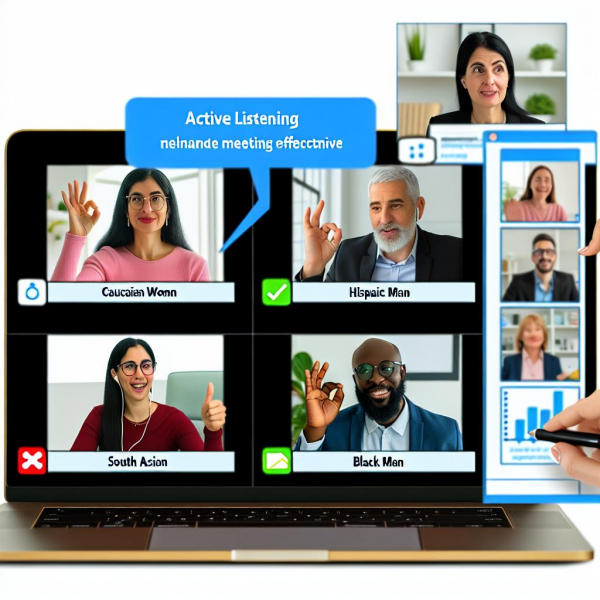Title: Engaging the Virtual Realm: Enhance the Effectiveness of Your Team Meetings!
Introduction:
In the ever-evolving landscape of today’s professional world, virtual team meetings have evolved to become the heartbeat of modern collaboration. As remote work gains prominence and technology binds us closer than ever before, it is imperative to unlock the full potential of virtual team meetings. To breathe life into this virtual realm, savvy facilitation skills are the secret ingredient to foster engagement, productivity, and ultimately, success.
Welcome to an exciting exploration dedicated to revolutionizing the way your virtual team meetings transpire. Unveiling a treasure trove of facilitation skills that will embolden your team, this article is your compass to navigating the vast expanse of virtual collaboration with flair and finesse.
From summoning creativity to nurturing inclusivity, we delve deep into the art of facilitation, applying it seamlessly to the digital realm. Bid farewell to monotony and disconnectedness as we unveil a world brimming with endless possibilities, where geographical distances melt away, and vibrant ideas flourish against the backdrop of the virtual sphere.
Through this enlightening journey, we will unravel the secrets of transcending the barriers imposed by screens, time zones, and cultural differences. Marvel at the transformative power of a skilled virtual facilitator who wields their talent like a conductor, orchestrating a symphony of ideas and harmonizing the diversity of minds in their digital symposium.
So, fasten your seatbelts as we embark upon an odyssey where virtual team meetings are no longer a mere means of communication, but rather an immersive experience that fuels creativity, sparks collaboration, and fosters the emergence of a stellar team spirit. Brace yourself for a wave of innovative facilitation techniques that will breathe life into your virtual meetings like never before.
Revolutionize your virtual team meetings today and unravel the true potential of digital collaboration through the wizardry of facilitation. Are you prepared to join us on this thrilling voyage where ordinary meetings fade into the shadow of extraordinary, awe-inspiring virtual gatherings? Let us set sail and navigate the unknown waters of virtual team meetings together!
Table of Contents
- Virtual Team Meetings: Facilitation Skills for Enhanced Effectiveness
- Keys to Building Rapport and Trust in Virtual Team Meetings
- Strategies for Managing Time and Attention in Virtual Team Meetings
- Effective Communication Techniques for Virtual Team Facilitation
- Mastering Virtual Collaboration Tools for Productive Virtual Team Meetings
- Navigating Conflict and Fostering Collaboration in Virtual Team Meetings
- Empowering Virtual Team Members: Encouraging Engagement and Participation
- Q&A
- Wrapping Up

Virtual Team Meetings: Facilitation Skills for Enhanced Effectiveness
In today’s ever-changing work landscape, virtual team meetings have become the norm. However, facilitating an effective virtual team meeting requires a unique set of skills. With the right facilitation skills, you can ensure that your virtual team meetings are more productive, engaging, and successful.
One essential skill for effective virtual team meetings is active listening. As a facilitator, it is important to actively listen to participants’ ideas, concerns, and feedback. This not only shows respect and empathy for your team members but also helps you gather valuable information and insights. To improve your active listening skills, consider implementing the following strategies:
- Maintain eye contact: Even in virtual meetings, maintaining eye contact is crucial. Look directly into the camera when speaking or listening to create a sense of connection with others.
- Ask clarifying questions: When someone shares their thoughts or ideas, ask for clarification to ensure that you fully understand their point of view. This also encourages participants to elaborate and provides clarity for everyone.
- Paraphrase and summarize: After someone shares their input, paraphrase and summarize their key points to demonstrate your understanding. This not only affirms their contribution but also helps consolidate information for the entire team.
By focusing on active listening, you can foster a collaborative and inclusive virtual meeting environment where every team member feels valued and heard. This, in turn, enhances the overall effectiveness of your virtual team meetings.

Keys to Building Rapport and Trust in Virtual Team Meetings
When it comes to virtual team meetings, building rapport and trust is essential for effective collaboration. Without the benefits of face-to-face interactions, it’s crucial to establish a strong foundation that promotes cohesion and open communication. Here are some key strategies to enhance rapport and trust in your virtual team meetings:
- Create a Welcoming Atmosphere: Begin each meeting by creating a positive and inclusive environment. Greet team members, encourage small talk, and acknowledge their contributions. Foster a sense of belonging and camaraderie to establish trust among team members.
- Set Clear Meeting Objectives: Clearly communicate the purpose and goals of each meeting. Provide an agenda in advance outlining topics to be discussed and expected outcomes. This helps everyone stay focused and understand the value of their participation, fostering trust in the process.
- Foster Active Participation: Encourage everyone to actively participate and share their thoughts and ideas. Use techniques like round-robin discussions or asking open-ended questions to ensure everyone’s voice is heard. This inclusive approach builds trust and shows that every team member’s input is valued.
By implementing these strategies, you can create a collaborative and trusting environment for your virtual team meetings. Remember, building rapport and trust takes time and effort, but the benefits of increased productivity, creativity, and satisfaction among team members make it well worth it!
| Strategy | Benefit |
| Create a Welcoming Atmosphere | Establish a sense of belonging and camaraderie |
| Set Clear Meeting Objectives | Keep everyone focused and understand the value of participation |
| Foster Active Participation | Show that every team member’s input is valued |

Strategies for Managing Time and Attention in Virtual Team Meetings
Effective management of time and attention is crucial for successful virtual team meetings. With the prevalence of remote work, it is essential to develop facilitation skills that can ensure these meetings are productive and engaging. By implementing the following strategies, you can make your virtual team meetings more effective:
- Set clear objectives: Clearly outline the purpose and specific goals of the meeting beforehand. This will help everyone stay focused and understand what needs to be accomplished.
- Create an agenda: Develop a structured agenda and share it with participants before the meeting. This will provide a roadmap for the discussion and keep the meeting on track.
- Allocate time wisely: Break down the agenda into time segments and allocate appropriate time for each item. Ensure that important topics are given sufficient time for discussion and decision-making.
- Encourage active participation: Engage all participants by asking for their input, opinions, and ideas. Encourage open dialogue and create an inclusive environment that values everyone’s contributions.
- Minimize distractions: Ask participants to eliminate distractions such as email notifications and phone calls during the meeting. Encourage them to find a quiet, dedicated space for better focus and attention.
By implementing these strategies, you can effectively manage time and attention in virtual team meetings, ultimately leading to more productive and efficient collaboration.
| Strategy | Objective |
|---|---|
| Set clear objectives | Ensure everyone understands the purpose and goals of the meeting |
| Create an agenda | Provide a structured roadmap for the discussion |
| Allocate time wisely | Ensure sufficient time for important topics |
| Encourage active participation | Promote engagement and diverse perspectives |
| Minimize distractions | Promote focus and attention |

Effective Communication Techniques for Virtual Team Facilitation
In today’s digital age, virtual team facilitation has become an integral part of effective communication. To make virtual team meetings more productive and engaging, it is crucial to possess the right facilitation skills. The ability to navigate technology, maintain a clear and concise communication style, and create an inclusive environment are some essential techniques that can enhance the effectiveness of virtual team facilitation.
One key technique to master is leveraging technology in virtual team meetings. Familiarize yourself with the various communication tools available, such as video conferencing platforms, collaboration software, and project management tools. This will not only help you effectively relay information but also enable seamless collaboration among team members. Additionally, ensure that the technology being used is reliable and user-friendly for all participants to avoid any technical difficulties or frustrations.
- Utilize screen sharing to present information clearly and visually.
- Encourage active participation by using chat features or polling tools.
- Provide agendas and relevant materials in advance to allow participants to prepare.
Another important skill is maintaining clear and concise communication throughout virtual team meetings. As participants may be working in different time zones or have limited attention spans, it is crucial to articulate ideas concisely and avoid unnecessary jargon. Practice active listening and encourage others to do the same to foster effective teamwork. Additionally, be sensitive to cultural differences and ensure that communication is inclusive and respectful of diverse perspectives.
| Benefits of : |
|---|
| Improved collaboration and productivity. |
| Enhanced understanding and clarity of project goals. |
| Increased engagement and active participation from team members. |
| Efficient problem-solving and decision-making processes. |
Mastering Virtual Collaboration Tools for Productive Virtual Team Meetings
Nowadays, virtual team meetings have become a staple in the business world, allowing remote teams to connect and collaborate seamlessly. However, with the increasing dependence on virtual collaboration tools, it’s essential to master these tools to ensure productive and effective virtual team meetings. Here are some ways to enhance your facilitation skills and optimize virtual collaboration:
- Choose the right virtual collaboration tool: With an array of virtual collaboration tools available, selecting the one that best suits your team’s needs is crucial. Consider features like video conferencing capabilities, screen sharing, and real-time document editing. Investing time and effort in understanding and mastering the chosen tool will significantly impact the success of your virtual team meetings.
- Establish clear meeting objectives and an agenda: Before every virtual team meeting, define clear and specific meeting objectives. Outline what needs to be accomplished during the meeting and share the agenda with all participants in advance. This will help set expectations, keep the meeting focused, and allow everyone to come prepared with relevant information and materials.
- Encourage active participation: In virtual team meetings, it’s essential to encourage active participation from all team members. Engage everyone by providing opportunities to contribute, ask questions, and share insights. Foster a collaborative environment where every voice is heard and valued.
| Collaboration Tool | Key Features | Cost |
|---|---|---|
| Zoom | Video conferencing, screen sharing, breakout rooms | Free (Basic Plan) $14.99/month (Pro Plan) |
| Microsoft Teams | Chat, document collaboration, video meetings | Free (Basic Plan) $5/user/month (Business Plan) |
| Slack | Instant messaging, file sharing, integrations | Free (Basic Plan) $6.67/user/month (Plus Plan) |
By mastering virtual collaboration tools and implementing effective facilitation skills, you can make your virtual team meetings more productive and engaging. When everyone feels valued and connected, remote teams can thrive, achieving their goals with efficiency and creativity.
Navigating Conflict and Fostering Collaboration in Virtual Team Meetings
In today’s modern work environment, virtual team meetings have become the norm. However, this shift from in-person to virtual meetings brings forth its own set of challenges, particularly when it comes to navigating conflict and fostering collaboration. Here are some essential facilitation skills you need to make your virtual team meetings more effective and productive.
Active Listening: Encourage your team members to express their thoughts and concerns openly. Practice active listening by giving each individual your undivided attention and paraphrasing their ideas to show that you understand their perspectives. This not only helps to resolve conflict but also promotes collaboration by making everyone feel heard and valued.
Establishing Clear Objectives: Before each virtual team meeting, set clear objectives and agenda items. Outline the main topics that need to be discussed and ensure that everyone is on the same page. By providing a clear focus for the meeting, you can avoid unnecessary conflicts and keep the discussions on track.
Encouraging Open Communication: Create an environment where team members feel comfortable sharing their ideas and opinions. Use icebreaker activities or team-building exercises to foster a sense of camaraderie and trust. Encourage open communication by asking for input from everyone and ensuring that all voices are heard.
Mediating Conflict: Conflict is inevitable, but it’s important to address it promptly and effectively. As a facilitator, your role is to mediate conflicts and find common ground. Use techniques like reflective questioning, where you ask team members to put themselves in each other’s shoes. This helps to promote understanding and empathy, leading to more collaborative solutions.
By honing your facilitation skills, you can create a positive and inclusive virtual team meeting environment. Emphasize active listening, establish clear objectives, encourage open communication, and mediate conflicts. These skills will not only help you navigate conflict and foster collaboration but will also make your virtual team meetings more effective overall.
Empowering Virtual Team Members: Encouraging Engagement and Participation
In today’s digital age, virtual teams have become increasingly common, allowing businesses to tap into a diverse range of talents from all over the world. However, managing and empowering virtual team members can present unique challenges. To ensure the success of your virtual team meetings, it’s crucial to foster engagement and active participation among team members.
One effective way to encourage engagement is to establish a clear agenda for each virtual team meeting. By providing an outline of the topics to be discussed and the meeting’s objectives, team members will be able to come prepared and contribute more effectively. Additionally, consider assigning specific roles to team members, such as timekeeper or note-taker, to ensure everyone has a designated responsibility and feels involved in the process.
To further enhance engagement, utilize interactive tools and features available in virtual meeting platforms. For instance, take advantage of polling and survey options to gather opinions and preferences from team members. This not only encourages participation but also helps in making informed decisions as a group. Moreover, incorporating breakout sessions or smaller group discussions can promote collaboration and allow team members to dive deeper into specific topics or challenges. Remember, the key to empowering virtual team members is to create an inclusive and collaborative environment where everyone feels their voice is valued.
Q&A
Q: Looking to make your virtual team meetings more effective?
A: Look no further! This article explores the essential facilitation skills you need to master for successful virtual team meetings.
Q: What challenges do virtual team meetings present?
A: Virtual team meetings come with their fair share of challenges. Some common issues include difficulty in maintaining engagement, overcoming technological glitches, managing time zones, and fostering effective communication.
Q: How can facilitation skills help overcome these challenges?
A: Facilitation skills play a crucial role in overcoming the challenges of virtual team meetings. By creating a structured and engaging virtual environment, facilitators can enhance communication, encourage active participation, and ensure effective collaboration.
Q: What are some essential facilitation skills for virtual team meetings?
A: Key facilitation skills for virtual team meetings include effective communication, active listening, clear goal-setting, time management, conflict resolution, and tech-savviness.
Q: How can effective communication be achieved in virtual team meetings?
A: To achieve effective communication, virtual facilitators should promote open dialogue, encourage everyone to contribute, and use various communication tools wisely. They should also set clear expectations for active participation and create a safe space for expressing ideas.
Q: Why is active listening important in virtual team meetings?
A: Active listening is crucial in virtual team meetings as it ensures all participants feel heard and understood. It allows facilitators to gather diverse perspectives, address concerns, and facilitate meaningful collaboration.
Q: How can facilitators manage time effectively during virtual team meetings?
A: Time management is essential for virtual team meetings to ensure everyone’s participation and maintain productivity. Facilitators can set clear agendas, allocate time slots for each agenda item, and remind participants to stay on track.
Q: What strategies can facilitators use to resolve conflicts in virtual team meetings?
A: Facilitators can implement conflict resolution strategies such as promoting open dialogue, encouraging empathy, and finding common ground. They should also be skilled in mediating disputes and help participants reach mutually satisfying solutions.
Q: How can facilitators improve their tech-savviness for better virtual team meetings?
A: To improve tech-savviness, facilitators should familiarize themselves with various virtual communication platforms, explore interactive tools and features, and troubleshoot technical issues efficiently. Ongoing training and practice can enhance their overall proficiency.
Q: Any additional tips for making virtual team meetings more effective?
A: Yes! To make virtual team meetings even more effective, facilitators should establish clear meeting objectives, encourage active participation through icebreakers and visual aids, and follow-up with meeting summaries and action points.
Q: Where can I find more resources on improving facilitation skills for virtual team meetings?
A: There are numerous online courses, books, and articles available that provide further insights on improving facilitation skills for virtual team meetings. Additionally, exploring case studies and networking with fellow facilitation practitioners can be valuable resources.
Wrapping Up
In this new era of virtual teamwork, the ability to facilitate effective meetings has become an essential skill. We have journeyed through the realm of virtual collaboration, exploring various techniques and strategies to make your team meetings truly meaningful and productive.
By harnessing the power of facilitation, you will not only navigate the challenges of distance and technology but also foster a sense of connection and synergy within your team. Through these tried-and-tested tips and tricks, you can confidently guide your virtual meetings towards success and leave a lasting impact on your team members.
Remember, a skilled facilitator listens attentively, encourages open dialogue, and ensures equal participation. By embracing these principles, you can create an inclusive environment where every team member feels heard and valued. Moreover, mastering the art of virtual facilitation means leveraging the diverse talents and perspectives within your team, unlocking their full potential.
During our voyage, we have delved into the realms of agenda setting, icebreakers, and technology. We examined how crafting a purposeful agenda sets the stage for focused discussions, while thoughtfully selected icebreakers foster team bonding and stimulate creativity. Additionally, we navigated the intricacies of technology, discovering how its seamless integration can enhance communication and collaboration.
But our journey does not end here. It is now your turn to embrace the role of a facilitator and embark on your own odyssey of virtual team meetings. Armed with the skills and knowledge gained, you have the power to transform each gathering into an environment of growth and achievement.
As we bid farewell, we encourage you to keep honing your facilitation skills. Seek continuous improvement, adapt to the ever-changing landscape of virtual collaboration, and remain open to exploring new strategies. By actively cultivating this mindset, you will not only elevate your own facilitation prowess but also inspire others to follow in your footsteps.
So, go forth, fellow facilitator, and conquer the virtual realm with your newfound skills. Armed with the ability to make every team meeting more effective, you hold the key to unlock the full potential of remote collaboration. Together, let us forge a path towards a more connected and productive virtual teamwork experience.
